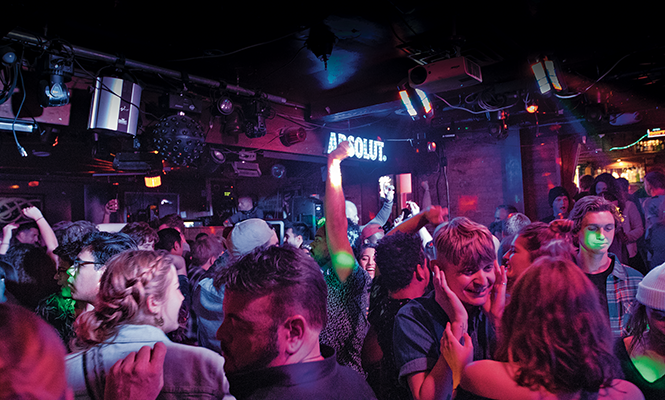Page 5 of 5

- John Taylor
- The Sun Trapp is named for two storied LGBTQ bars—the Sun Tavern and the Trapp—from Salt Lake City’s past.
Out on the Town
Five decades of women's bars, brawls and badassery in SLC.
By Babs de Lay
It was 50 years ago that I came out of the closet, recognizing that I was not heterosexual. I didn't dislike sex with men, I just had no emotional connection with my sex partners.
Back in the early 1970s, the world was changing rapidly in this country, from the Vietnam War protests to high inflation and gas lines. It was a tumultuous time from coast to coast, when African Americans, Native peoples, gays and lesbians, women and other marginalized people were protesting and rioting for equality and fair treatment.
I marched along with so many others demanding our rights. Some lesbians I knew threw in the towel—seeing no end to discrimination—and moved to the Pacific Northwest to create "women's land" separatist communities, often in the woods, where no man was to enter.
Sneaking into gay bars like the Sun Tavern and Radio City in Salt Lake City was easy if you were underage, because it took little effort to forge a fake driver's license back then. A friend and I wanted desperately to go inside the only women's bar at the time—Perkys—located just west of where the Triad Center stands today.
We didn't know if our fake IDs would work, but we fortified our spirits with cheap beer at the Sun and walked under the viaduct and over to the little shack that was hopefully going to be our new hangout and place of opportunity to meet women. As we approached the front door, I shoved my buddy to go ahead of me, but damned if the door didn't open!
Lo and behold, there was a small sign on the door: "Thanks for all your business! We're retiring to Idaho!" It was closed forever, as Perky (nickname) and her partner followed their bliss to a small ranch up north to raise sheep.
The oldest gay bar west of the Mississippi was Radio City Lounge at 147 S. State. I performed there as the first drag "king" the local boys had ever seen and won the talent show for my rendition of "If I Were a Rich Man" from Fiddler on the Roof.
It was a men's bar, and with Perky's gone, there was a great need for empowered women coming out of the closet to gather in safe spaces. The Sun Tavern was originally located where Vivint Arena is now located, and a women's bar opened next door originally known as The Upton Place, then later as Sisters.
In my opinion, the unique thing about the LGBTQ community here is that we have always had a mutual understanding that we are a minority in Utah, and we need to stick together. Women were welcome in men's bars and vice versa, and it remains that way today.
Gay bashing was common in the Downtown area, where the majority of gay bars were located. Both men and women were victims of thugs, and we all had to be careful leaving the bars to avoid being beaten with baseball bats. On the flip side—we marched, we became visible and some locals were terrified.
When Florida orange juice spokeswoman Anita Bryant came to the 1977 Utah State Fair to perform her Christian pop songs, the LGBTQ community came out to protest her anti-homosexual ranting and ravings. The entire Utah State Fairgrounds was surrounded by state and local police in anticipation of the chaos we were allegedly going to bring to the event.
Actually, our only plan was to sit in the stands as she began to perform, and then to stand up en masse and walk out. About 100 of us did just that, without incident. We were out and proud.
In the 1980s, another women's bar opened—Puss and Boots on Redwood Road. It was the largest bar of its type ever to open in Utah, and women from Idaho and Wyoming joined local lesbians, bisexuals and gay men on the weekends to dance the night away.
After that bar closed, there was a pause in women's bars, but plenty of gay bars still attracted the gay and straight community for drag shows, great music and dancing. Club Jam (closed), Club Sound (closed), Try-Angles (open) and The Sun Tavern (damaged by a tornado, but living on in spirit at The Sun Trapp) provided entertainment. In time, a new bar, The Paper Moon, opened for women.
It closed about a decade ago, along with Mo Diggity's, a women's sports bar that I opened with two former employees of The Paper Moon.
Today, more bars are opening but none are specifically labeled as gay bars for women. But there are plenty of bars that are hella gay friendly in Utah.
In the late '80s there were an estimated 200 lesbian bars across the country. Last year, NBC news reported that there were only 16 lesbian bars left in the U.S., compared to about 1,000 bars that cater to gay men and mixed-gender LGBTQ crowds.
This is sad because it's difficult for gay women to meet and socialize, and thus social media has become necessary for singles to meet. Recent reporting from PBS also addressed the issue of the end of lesbian bars, suggesting the trend was exacerbated by the prevalence of dating apps.